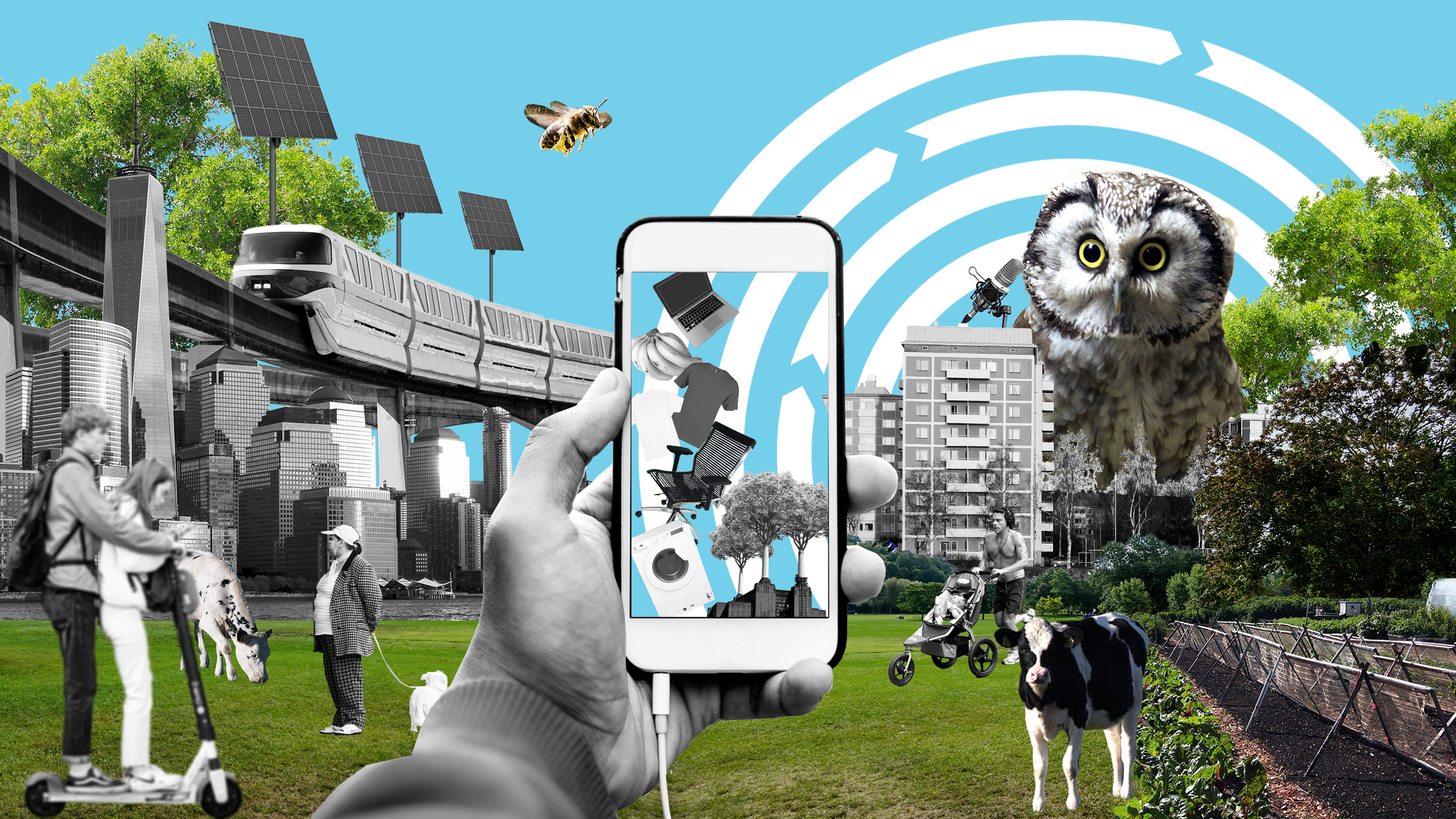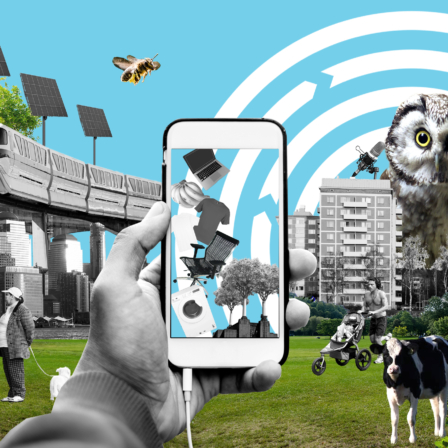The British OLIO is an application that makes it easy to share extra food and ingredients between neighbours. Anyone can upload a picture of their excess food items or browse the products reported by their neighbours. The app makes reducing food waste easy and you might even get to know your neighbour while using it.
Half of the world’s food waste is generated by households, and we desperately need circular solutions like OLIO. OLIO already operates in 49 countries and has more than 2.6 million users.
The current linear economic model is placing great strain on the earth’s carrying capacity by accelerating the climate crisis, biodiversity loss and the overuse of natural resources. Well-being is unevenly distributed, and inequality is increasing.
A circular economy The circular economy An economic model which does not focus on producing more and more goods, but in which consumption is based on using services – sharing, renting and recycling – instead of owning. Materials are not destroyed in the end, but are used to make new products over and over again. Open term page The circular economy that does not continuously produce more goods but uses the value of the products and materials in use for as long as possible is one solution to these challenges.
A recent Sitra study “The winning recipe for a circular economy” examines effective, interesting and profitable circular economy solutions from around the globe. The report is based on surveys and interviews carried out with companies developing circular economy solutions. Sitra used the material to compile a list of 39 inspiring circular economy solutions from around the globe.
According to the study, successful circular economy solutions have five factors in common.
Co-operation is the key
The success of circular economy solutions is based on networked activities. Collaboration with other companies, the public sector and, for example, research institutes, already needs to begin in the product or service development phase.
The Swedish company Renewcell has developed a recycling process for cotton and viscose textiles. The Circulose fibre produced in the process can be used for making clothes in the same manner as virgin textile fibres. To ensure that the product can truly replace virgin materials and thus contribute to the transition of the clothing industry to a circular economy, large fashion chains were involved in the development work from the outset.
The Kenyan company Safi Organics produces a fertiliser for small farmers. The product was developed in collaboration between local farmers, a Kenyan research institute, experts and the leading university MIT. The Safi Organics fertiliser is ecologically sustainable, and the decentralised fertiliser production helps create jobs and reduce the dependence of small farmers on imported fertilisers.
Data is important
Transition to a circular economy means that business must be figured out in a new way. In the process, data and technology tools play a key role.
From the perspective of the reuse of materials, information is needed on the materials contained in products and on how the materials can be kept in circulation when products reach the end of their life cycle. In Sitra’s study “The winning recipe for a circular economy”, companies specialising in the development, collection and sharing of this kind of data are called the enablers of a circular economy.
The North American Optel Group has developed an online platform that enables companies to track their material flows until the end of the products’ life cycles. Detailed end-to-end material traceability increases the opportunities to reuse materials, thus reducing the need for virgin materials.
Tools enabling businesses to measure their level of circularity are important as they produce objective and measurable data on the benefits provided by the circular economy. The tools also help companies identify possibilities for developing circular business models.
The Circular Transition Indicators (CTI Tool) is a tool measuring the level of circularity in a company’s operations that also enables transparent reporting and, consequently, the harmonisation of full value chains.
However, data should not be harnessed for circular economy use simply because it is made available. The cloud services and technology infrastructure needed for data processing increase energy consumption and require natural resources, such as precious metals. As with other solutions, data-based circular economy solutions should reduce the burden on the environment, not increase it.
Pioneers within their fields
Providers of circular economy solutions are still largely pioneers in their own fields.
To have others follow in the pioneers’ footsteps, companies must have a crystal-clear value creation model and communicate it to stakeholders in clear terms. Customers and investors value and require accurate information and concrete evidence of the benefits produced by the solution. Information is needed for assessing the future prospects of the solution and lowering the investment risks.
One example of a pioneering company is the Canadian Li-Cycle, which has developed a new method for lithium-ion battery resource recovery. The solution stems from customer needs: traditional recycling methods have not enabled the recovery of all battery minerals in a way that means they can be reused.
Reporting on value creation is especially important for companies with a new business model or a model that differs from previous ones. Running a circular business is not yet mainstream, so it is important to provide measurable evidence of the functionality and necessity of circular economy models. In addition to having a clear value creation model, Li-Cycle has clearly communicated how the circular economy responds to the increased need for battery minerals caused by the electrification of society.
Native or adapted solutions
According to Sitra’s study “The winning recipe for a circular economy”, successful circular economy solutions can be based on two approaches. For those creating “native solutions”, the starting point is doing everything with circularity in mind from the very beginning. On the other hand, there are also successful, traditional companies adapting their operations by reshaping existing models or adding circular elements to them.
The Dutch DSM-Niaga is a good example of a creator of native circular solutions. The company designs home textiles for circularity. The materials used in the products, from fibres to adhesives, are designed so that they can be used again and again for the same purpose.
The Finnish Kotkamills is a company that has adapted its operations. The long-established packaging producer has managed to adapt to meet the growing recycling needs of the sector. The company developed a packaging material made from forest industry side streams and coated with a thin polymer film to replace traditional disposable plastic packages. The packaging can be easily recycled in the existing recycling system.
In other words, the circular economy does not require that traditional companies need to make way for new ones. For both those creating native circular solutions and those adapting their operations it is possible to succeed and involve others in the transition.
Socially and ecologically sustainable solution
Boosting the ecological and social impacts of products in a profitable manner is one of the cornerstones of successful solutions. According to the World Economic Forum (WEF), start-ups that aim for positive social impact alongside financial profit are 43% more likely to break into the market than traditional, profit-oriented start-ups.
Resource-efficient solutions typical of a circular economy often bring direct environmental benefits, for example, by reducing emissions or the need for virgin materials.
The circular economy also has undeniable potential to increase people’s well-being and improve their quality of life. For example, Blendhub, which produces food processing equipment as-a-service, has strengthened the position of small food producers by developing a modular factory that enables the processing of food on site and improves its preservability. The solution also provides environmental benefits by reducing food waste and shortening food production chains.
A circular economy society is far from ready
The circular economy creates business opportunities based on the sustainable and continuous use of natural and other resources within the limits of the planet’s carrying capacity. However, according to the Circularity Gap report prepared by Circle Economy, the world is still only 8.6 per cent circular.
Initiatives that accelerate the success of circular economy solutions already exist. For example, Project Zero is a non-profit organisation that promotes the creation of networks that are important for the emergence of circular solutions.
Examples like Project Zero are significant, as they promote the cross-cutting change that transition to a circular economy requires in society in the areas of decision-making, consumer behaviour and financing, and they bring together parties whose collaboration is a prerequisite for the circular economy. The change will not happen by itself – we all need to pitch in.









Recommended
Have some more.